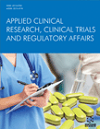- Home
- A-Z Publications
- Applied Clinical Research, Clinical Trials and Regulatory Affairs
- Previous Issues
- Volume 5, Issue 3, 2018
Applied Clinical Research, Clinical Trials and Regulatory Affairs - Volume 5, Issue 3, 2018
Volume 5, Issue 3, 2018
-
-
Nanotechnology: A Modern Contraption in Cosmetics and Dermatology
More LessAuthors: Neelam Sharma, Sukhbir Singh, Neha Kanojia, Ajmer S. Grewal and Sandeep AroraBackground: Nanoscience is the section of science related to the study of minute particles on an atomic or molecular scale, whose size is measured in nanometres. Nanotechnology serves as one of the most capable technologies and accomplished approaches of the 21st century which is safe and efficacious for novel drug delivery systems. Now, nanotechnology is used widely in the field of cosmetics and dermatology due to th Read More
-
-
-
Herbal Nano Formulations: Patent and Regulatory Overview
More LessAuthors: Surbhi Dhawan, Partibha Hooda and Sanju NandaHerbals have been explored worldwide from ancient times for their innumerable therapeutic applications. Despite the advantages, phytomedicines encounter several drawbacks like toxicity, lower bioavailability, stability problem and patient compliance. To overcome these constraints researchers came up with the introduction of Novel Drug Delivery Systems (NDDS). These included polymeric liposomes, nanolipid carri Read More
-
-
-
Regulatory Success and Challenges for Medical Devices in United States and European Union
More LessAuthors: Aashu Rohilla, Aakash Deep, Gaurav Khurana, Monu Yadav, Rakesh K. Marwaha and Prabodh C. SharmaMedical devices are the tool, machine, apparatus, instrument, implant, calibrator in vitro, software, the similar or related object intended for use by the manufacturer alone or in combination becoming increasingly important in the healthcare sector as these are used to diagnosis, control, treatment or prevention of an illness. Demand for medical devices around the world has drawn the attention of government agencies to Read More
-
-
-
A Review on Sublingual Route is the Most Promising Choice in an Emergency
More LessAuthors: Monika N. Madibone, Sachin S. Gaikwad and Vikrant K. NikamSublingual route increases the efficacy of the drug by dissolving in few seconds in the oral cavity. Being a fast dissolving tablet the sublingual tablet is mostly acceptable in an emergency because it does not require chewing as well as water for administration. An important advantage of the sublingual route is that it bypasses the hepatic circulation of the drug ultimately increasing the bioavailability of the drug with rapid onse Read More
-
Most Read This Month
Article
content/journals/acctra
Journal
10
5
false
en

Most Cited Most Cited RSS feed
-
-
-
A Rapid LC-ESI-MS/MS Method for the Quantitation of Salicylic Acid, an Active Metabolite of Acetylsalicylic Acid: Application to in vivo Pharmacokinetic and Bioequivalence Study in Indian Healthy Male Volunteers
Authors: Dhiman Halder, Shubhasis Dan, Easha Biswas, Pradipta Sarkar, Umesh C. Halder and Tapan K. Pal
-
- More Less

